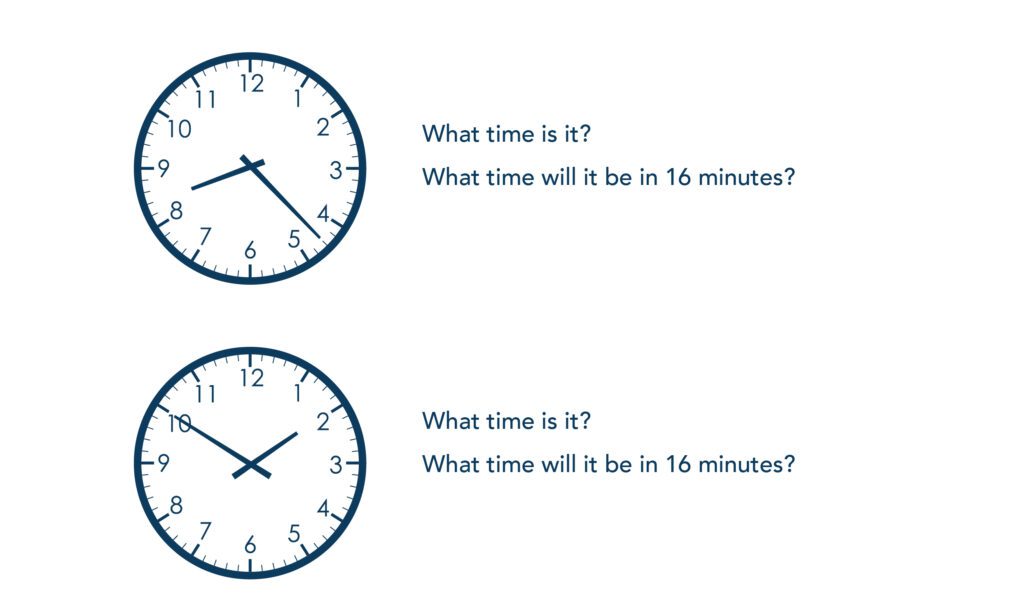This blog was previously published in 2016 and has since been updated.
At the heart of effective standards-based work is calibrating our understanding of what our students should know and be able to do. True calibration doesn’t happen in one planning period, and it doesn’t happen in isolation.
Calibration Through Collaboration: Asking the Questions
Take a careful look at the three different questions below. What do you notice? What do you wonder?

I notice that all of these questions could be used to assess a third-grade standard about telling and measuring time. I wonder how the questions I use to assess this standard will impact the instructional decisions I make? In Maine, third-grade students are expected to meet the following math standard:
Tell and write time to the nearest minute and measure time intervals in minutes. Solve word problems involving addition and subtraction of time intervals in minutes, e.g., by representing the problem on a number line diagram.
This standard seems fairly straightforward. Most people would agree that telling time is important. What is all the controversy about? Kids should know how to tell time. End of story. Actually, it is only the beginning of a long and complex story, a story that is often written with a choose-your-own-adventure structure, instead of one with a cohesive plot and an intentional theme.
In the choose-your-own-adventure model, teachers work independently to teach and assess the standards. They might share resources, but not their concept of what it means to understand the standards.
The problem with the “choose-your-own-adventure” model is that the questions mentioned above assess different skills and concepts, yet, they could all be aligned with the same standard. Each of the questions above has a different level of cognitive complexity.
Question One
The first question asks students to recall and apply the procedure for reading an analog clock.
The students will have to recognize the hour and minute hand and remember that the bold numbers on the clock represent groups of 5 minutes. The students may count by fives and then ones to determine that the clock reads 8:22. The students can complete this task without grappling with how the units we use to measure time are related.
Questions Two and Three
The second and third questions address some of the nuances associated with telling and tracking time.
I intentionally chose the clock for the second question because the hour hand is difficult to read. Is it 1:50 or 2:50? Also, in order for me to determine what time it will be in 16 minutes, I have to understand the relationship between seconds, minutes, and hours. I have to change my unit when I get to 2 o’clock. I have to engage in a higher level of analysis to solve problem two.
The third question is one that I have adapted from the website Open Middle. Robert Kaplinsky’s blog posts have helped me think more about depth of knowledge when I use questions to assess student understanding.
This question requires the highest level of analysis because it asks students to synthesize several concepts and continually revise their thinking. For example, when I solved this problem, I figured out that the start time has to be close to the end of an hour because I can only use each digit once.
We need to collectively agree on a level of complexity and create a standard scale to measure it. Students construct understanding over time as they gradually connect an intricate web of meaningful experiences.
Our collective understanding of what our students know and can do mirrors the journey of our students. It is essential for us to check in with each other on this journey to ensure consistency and coherence.
Meeting the Standards
Determining whether or not a student has met a standard is not as simple as it seems. It requires reflecting on how our instruction is impacting student learning.
- What did my students learn?
- How do I know they learned it?
- What should I do next?
You can’t find the answers to these questions by yourself because learning doesn’t take place in a vacuum, and it usually isn’t linear. The minute we start doing this work in isolation, we have lost sight of the reason for shifting to a standards-based system because your idea of “meeting a standard” is my idea of “partially meeting a standard” and is his idea of “exceeding” a standard.
Calibrating agreement on proficiency for a standard can be found in the conversations that happen with colleagues while reading about standards, analyzing student work, planning and teaching together, observing each other, and doing math together – lots and lots of math together.
For third-grade teachers, these conversations would explore the relationships between the units we use to measure time. This communication should be consistent and clear while simultaneously ensuring that the nuances of deep understanding do not get lost in an attempt to translate concisely. It is not sufficient to just calibrate scoring of student work, we also need to learn from each other how our instruction impacts student learning.
In Summary
True collaboration is challenging and messy. It can be crippling at times. It can cause feelings of constraint and frustration, but it is worth working through these feelings and holding to the expectation of a cohesive, transparent understanding of what our students will know and be able to do.
About the Author:
Sarah Caban is a Math Coach in Maine.

